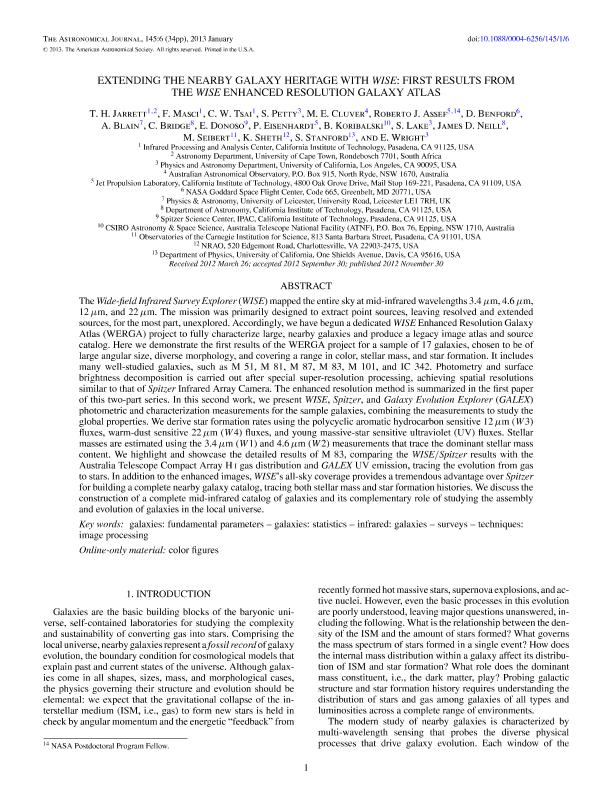Artículo
Extending the nearby galaxy heritage with wise: First results from the wise enhanced resolution galaxy atlas
Jarrett, T. H.; Masci, F.; Tsai, C. W.; Petty, S.; Cluver, M. E.; Assef, Roberto J.; Benford, D.; Blain, A.; Bridge, C.; Donoso, Emilio ; Eisenhardt, P.; Koribalski, Bärbel; Lake, S.; Neill, James D.; Seibert, M.; Sheth, K.; Stanford, S.; Wright, E.
; Eisenhardt, P.; Koribalski, Bärbel; Lake, S.; Neill, James D.; Seibert, M.; Sheth, K.; Stanford, S.; Wright, E.
 ; Eisenhardt, P.; Koribalski, Bärbel; Lake, S.; Neill, James D.; Seibert, M.; Sheth, K.; Stanford, S.; Wright, E.
; Eisenhardt, P.; Koribalski, Bärbel; Lake, S.; Neill, James D.; Seibert, M.; Sheth, K.; Stanford, S.; Wright, E.
Fecha de publicación:
01/2013
Editorial:
IOP Publishing
Revista:
Astronomical Journal
ISSN:
0004-6256
Idioma:
Inglés
Tipo de recurso:
Artículo publicado
Clasificación temática:
Resumen
The Wide-field Infrared Survey Explorer (WISE) mapped the entire sky at mid-infrared wavelengths 3.4 μm, 4.6 μm, 12 μm, and 22 μm. The mission was primarily designed to extract point sources, leaving resolved and extended sources, for the most part, unexplored. Accordingly, we have begun a dedicated WISE Enhanced Resolution Galaxy Atlas (WERGA) project to fully characterize large, nearby galaxies and produce a legacy image atlas and source catalog. Here we demonstrate the first results of the WERGA project for a sample of 17 galaxies, chosen to be of large angular size, diverse morphology, and covering a range in color, stellar mass, and star formation. It includes many well-studied galaxies, such as M51, M81, M87, M83, M101, and IC342. Photometry and surface brightness decomposition is carried out after special super-resolution processing, achieving spatial resolutions similar to that of Spitzer Infrared Array Camera. The enhanced resolution method is summarized in the first paper of this two-part series. In this second work, we present WISE, Spitzer, and Galaxy Evolution Explorer (GALEX) photometric and characterization measurements for the sample galaxies, combining the measurements to study the global properties. We derive star formation rates using the polycyclic aromatic hydrocarbon sensitive 12 μm (W3) fluxes, warm-dust sensitive 22 μm (W4) fluxes, and young massive-star sensitive ultraviolet (UV) fluxes. Stellar masses are estimated using the 3.4 μm (W1) and 4.6 μm (W2) measurements that trace the dominant stellar mass content. We highlight and showcase the detailed results of M83, comparing the WISE/Spitzer results with the Australia Telescope Compact Array H I gas distribution and GALEX UV emission, tracing the evolution from gas to stars. In addition to the enhanced images, WISE's all-sky coverage provides a tremendous advantage over Spitzer for building a complete nearby galaxy catalog, tracing both stellar mass and star formation histories. We discuss the construction of a complete mid-infrared catalog of galaxies and its complementary role of studying the assembly and evolution of galaxies in the local universe.
Archivos asociados
Licencia
Identificadores
Colecciones
Articulos(ICATE)
Articulos de INST.D/CS ASTRONOMICAS D/LA TIERRA Y DEL ESPACIO
Articulos de INST.D/CS ASTRONOMICAS D/LA TIERRA Y DEL ESPACIO
Citación
Jarrett, T. H.; Masci, F.; Tsai, C. W.; Petty, S.; Cluver, M. E.; et al.; Extending the nearby galaxy heritage with wise: First results from the wise enhanced resolution galaxy atlas; IOP Publishing; Astronomical Journal; 145; 1; 1-2013; 6-40
Compartir
Altmétricas
Items relacionados
Mostrando titulos relacionados por título, autor y tema.
-
Artículo New quantitative nitrogen abundance estimations in a sample of Seyfert 2 active galactic nucleiDors Jr., O. L.; Arellano Córdova, K. Z.; Cardaci, Monica Viviana ; Hägele, Guillermo Federico (Wiley Blackwell Publishing, Inc, 2017-06)
-
Dors, Oli L.; Agarwal, B.; Hägele, Guillermo Federico ; Cardaci, Monica Viviana ; Rydberg, Claes Erik; Riffel, R. A.; Oliveira, A. S.; Krabbe, A. C. (Wiley Blackwell Publishing, Inc, 2018-09)
-
Carvalho, S.P.; Dors, O. L.; Cardaci, Monica Viviana ; Hägele, Guillermo Federico ; Krabbe, Nora Cristina; Pérez Montero, E.; Monteiro, A.F.; Armah, M.; Freitas Lemes, P. (Wiley Blackwell Publishing, Inc, 2020-06)



